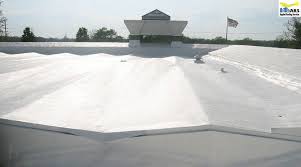
The Benefits of Poly Foam Roofing Systems
Poly foam roofing systems, also known as spray polyurethane foam (SPF) roofing, have gained popularity in the construction industry due to their numerous advantages. This innovative roofing solution offers a range of benefits that make it a cost-effective and sustainable choice for both residential and commercial buildings.
Energy Efficiency
One of the key advantages of poly foam roofing systems is their exceptional energy efficiency. The seamless application of SPF creates a continuous insulation layer that helps reduce heat transfer, keeping indoor spaces cooler in summer and warmer in winter. This thermal barrier can lead to significant energy savings on heating and cooling costs over time.
Waterproofing
Poly foam roofing systems provide excellent waterproofing properties, effectively sealing the roof against water infiltration. The closed-cell structure of SPF prevents moisture from seeping through, reducing the risk of leaks and water damage. This feature makes poly foam roofs ideal for areas prone to heavy rainfall or extreme weather conditions.
Durability
SPF roofs are known for their durability and longevity. When properly installed and maintained, poly foam roofing systems can last for decades without needing major repairs or replacements. The seamless nature of SPF application eliminates seams and joints where leaks often occur in traditional roofing materials, enhancing the overall lifespan of the roof.
Lightweight Construction
Another advantage of poly foam roofing systems is their lightweight nature. SPF is significantly lighter than many other roofing materials, reducing structural stress on buildings and allowing for easier installation. The lightweight properties of poly foam also make it an ideal choice for retrofitting existing roofs without adding excessive weight.
Sustainability
As an environmentally friendly option, poly foam roofing systems contribute to sustainable building practices. SPF is a highly efficient insulating material that can help reduce carbon emissions by lowering energy consumption for heating and cooling. Additionally, SPF roofs can be recoated or refurbished rather than replaced entirely, minimizing waste generation during maintenance.
In conclusion, poly foam roofing systems offer a range of benefits that make them a smart choice for modern construction projects. From energy efficiency and waterproofing to durability and sustainability, SPF roofs provide long-term value for building owners looking to invest in a reliable and eco-friendly roofing solution.
Understanding Polyurethane Foam Roofing: Materials, Lifespan, Benefits, and Drawbacks
- What kind of foam is used for roofing?
- How long does a polyurethane foam roof last?
- What is a polyurethane foam roof?
- What are the disadvantages of a foam roof?
What kind of foam is used for roofing?
Poly foam roofing systems typically use spray polyurethane foam (SPF) for their insulation and waterproofing properties. SPF is a versatile material that is applied as a liquid and expands into a foam, creating a seamless and durable roofing membrane. This closed-cell foam provides excellent thermal insulation, effectively sealing the roof against water infiltration, and offering long-lasting protection against the elements. SPF is known for its energy efficiency, lightweight construction, and sustainability, making it a popular choice for both residential and commercial roofing applications.
How long does a polyurethane foam roof last?
Polyurethane foam roofs are known for their exceptional durability and longevity, often lasting up to 25-30 years or more with proper maintenance and care. The lifespan of a poly foam roofing system can vary depending on factors such as installation quality, climate conditions, and maintenance practices. Regular inspections, timely repairs, and recoating can help extend the life of a polyurethane foam roof, ensuring that it continues to provide reliable protection and energy efficiency for many years to come.
What is a polyurethane foam roof?
A polyurethane foam roof, also known as a poly foam roofing system, is a type of roofing solution that involves the application of spray polyurethane foam (SPF) to create a seamless and durable insulation layer on the roof surface. This innovative roofing material is lightweight, energy-efficient, and provides excellent waterproofing properties. Polyurethane foam roofs are known for their longevity and sustainability, offering building owners a cost-effective and eco-friendly option for protecting their structures against the elements. The closed-cell structure of SPF prevents water infiltration and helps regulate indoor temperatures, making it a popular choice for both residential and commercial buildings seeking reliable and long-lasting roofing solutions.
What are the disadvantages of a foam roof?
Disadvantages of Foam Roofing Systems
While poly foam roofing systems offer numerous benefits, it is important to consider their potential drawbacks as well. One common disadvantage of foam roofs is their susceptibility to physical damage from foot traffic or falling objects. Unlike traditional roofing materials that may withstand impact better, SPF can be punctured or torn if not handled carefully.
Another concern with foam roofs is their maintenance requirements. Over time, UV exposure can cause the outer layer of SPF to degrade, leading to discoloration and reduced performance. Regular inspection and recoating are necessary to maintain the integrity of the roof and prevent premature deterioration.
Additionally, installation of poly foam roofing systems requires specialized equipment and trained professionals. Improper application can result in inadequate insulation, air leakage, or other performance issues that may compromise the effectiveness of the roof.
Despite these disadvantages, proper care and maintenance can help mitigate potential issues associated with foam roofs, ensuring long-term durability and performance.
